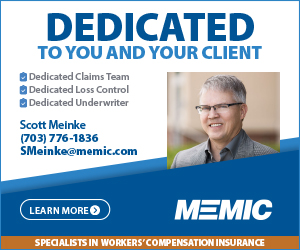Collapse Coverage
Print this Article | Send to Colleague
Collapse Coverage
by Bill Wilson, CPCU, ARM, AIM, AAM
The recent tragedy in Surfside, Florida has raised questions about what coverage commercial property forms provide or don’t provide for building collapse. From the standpoint of ISO industry standard forms, collapse is addressed by ISO’s primary Causes of Loss forms.
This article references ISO’s CP 10 30 10 12 – Causes Of Loss – Special Form and, given that Florida has legislated coverage for certain types of collapse, the ISO CP 01 25 02 12 – Florida Changes endorsement.
First of all, the CP 10 30 form EXCLUDES collapse of property or any part of the property, including:
(1) An abrupt falling down or caving in;
(2) Loss of structural integrity, including separation of parts of the property or property in danger of falling down or caving in; or
(3) Any cracking, bulging, sagging, bending, leaning, settling, shrinkage or expansion as such condition relates to (1) or (2) above.
However, there are three categorical exceptions to the exclusion. First, if the collapse results in a Covered Cause of Loss at the described premises, the loss or damage caused by that ensuing cause of loss is covered. Second, the exclusion doesn’t apply to the extent that coverage is provided by the Additional Coverage – Collapse. Third, collapse is covered if caused by the “specified causes of loss,” breakage of building glass, weight of rain that collects on a roof, or weight of people or personal property.
“Specified causes of loss” means fire, lightning, explosion, windstorm or hail, smoke, aircraft or vehicles, riot or civil commotion, vandalism, leakage from fire-extinguishing equipment, sinkhole collapse, volcanic action, falling objects, weight of snow, ice or sleet, and water damage. The form elaborates on what is meant by sinkhole collapse, falling objects, and water damage. For example, sinkhole collapse means the sudden sinking or collapse of land into underground empty spaces created by the action of water on limestone or dolomite. More on this later.
The Additional Coverage – Collapse essentially covers only abrupt collapse due to certain named perils. “Abrupt collapse” means an abrupt falling down or caving in of a building or any part of a building with the result that it cannot be occupied for its intended purpose. The collapse must be cause by one or more of the following [emphasis added]:
a. Building decay that is hidden from view, unless the presence of such decay is known to an insured prior to collapse;
b. Insect or vermin damage that is hidden from view, unless the presence of such damage is known to an insured prior to collapse;
c. Use of defective material or methods in construction, remodeling or renovation if the abrupt collapse occurs during the course of the construction, remodeling or renovation;
d. Use of defective material or methods in construction, remodeling or renovation if the abrupt collapse occurs after the course of the construction, remodeling or renovation, but only if the collapse is caused in part by…a cause of loss listed in a. or b., a “specified causes of loss,” breakage of building glass, weight of people or personal property, or weight of rain that collects on a roof.
The Additional Coverage – Collapse does NOT apply to:
a. A building or any part of a building that is in danger of falling down or caving in;
b. A part of a building that is standing, even if it has separated from another part of the building; or
c. A building that is standing or any part of a building that is standing, even if it shows evidence of cracking, bulging, sagging, bending, leaning, settling, shrinkage or expansion.
The Additional Coverage – Collapse fills an entire page, but the above are the provisions likely most applicable to the case in question.
So, would there be collapse coverage for the property in question under this ISO form? As is often the case, it depends. In this case, it depends on what caused the collapse. At this point, it is only speculation as to what contributed to the collapse. Was it a construction defect? Maintenance issue? Sinkhole collapse or other form of earth movement?
Early speculation has centered on roof renovations, construction on adjacent property, several years of sinking of the building at a rate of perhaps 2 mm a year, possibly inadequate columnar support in the parking garage, and the list goes on. The local media have reported anecdotal stories from residents about large cracks and standing water in the garage. One account from the husband of one of the residents is that his wife called to tell him that a large “crater” had appeared in the pool area. Other media reports suggest that an engineering report from 3 years ago found structural issues.
Under the ISO CP 10 30, the first possible exception to the collapse exclusion is for sinkholes, but this term refers specifically to the sudden sinking or collapse of land into underground empty spaces created by the action of water on limestone or dolomite. Was that the source of the “crater” allegedly reported? Was the nature of the foundational strata conducive to such an event? None of the other “specified causes of loss” appear to be material.
That leads us to the Additional Coverage – Collapse. From the discussion above, neither the b. nor c. perils appear to apply and d. would only apply to sinkhole collapse. That leaves peril a., building decay, an interpretation of what is meant by building “decay,” and whether it was hidden from view or unknown to an insured. These questions cannot be answered yet.
With regard to the portion of the building still standing, the Additional Coverage – Collapse does not appear to apply absent an actual collapse or case law to the contrary. Of particular importance here, IF there is coverage, could be the extent of Ordinance Or Law coverage to demolish the “undamaged” portion of the building and rebuild in compliance with any building code changes since the building was originally constructed 40 years ago.
A final complication is Florida’s “catastrophic ground cover collapse” law (Section 627.706) that is incorporated into the ISO CP 01 25 endorsement. The ISO form provides for coverage for catastrophic ground cover collapse, “meaning geological activity” that results in ALL of the following:
1. The abrupt collapse of the ground cover;
2. A depression in the ground cover clearly visible to the naked eye;
3. “Structural damage” to the building, including the foundation; and
4. The insured structure being condemned and ordered to be vacated by the governmental agency authorized by law to issue such an order for that structure.
This concept is new to me and, again, the circumstances of the loss are largely unknown at this time, so it’s too early to say whether this coverage may override the collapse and earth movement exclusions or whether the association had sinkhole coverage that applies. For that matter, except for statutorily required coverage, the policy forms in place may not be ISO standard forms at all.
If it turns out that there is no coverage or the amount is limited, that might make a case of the value of Differences In Conditions (DIC) coverage if available. Needless to say, the general and professional liability policies in force will like be tested.
One early lesson learned is the potential complexity of collective ownership of property. Who is responsible for risk management and insurance? Is property adequately insured, under both master policies and individual unit owner policies, from the standpoint of limits and perils? Is D&O coverage provided and adequate? Have unit owners purchased adequate Loss Assessment coverage under their policies?
If anything, this tragedy dispels the myth that someone can buy insurance in 15 minutes or less. Loss exposure analysis is critical and ongoing, requiring expertise beyond that of most owners and occupants. It is an investment of time that only takes an instant to pay for itself.
---------------------------------------------------------------------------------------------------------
Bill Wilson, CPCU, ARM, AIM, AAM is the former Assoc. VP of Education and Research for the IIABA National. Since retiring from the Big “I” in 2016, he has published six books and blogs regularly from his web site at www.InsuranceCommentary.com. In his spare time, he plays lead guitar with his band The Spyders.



